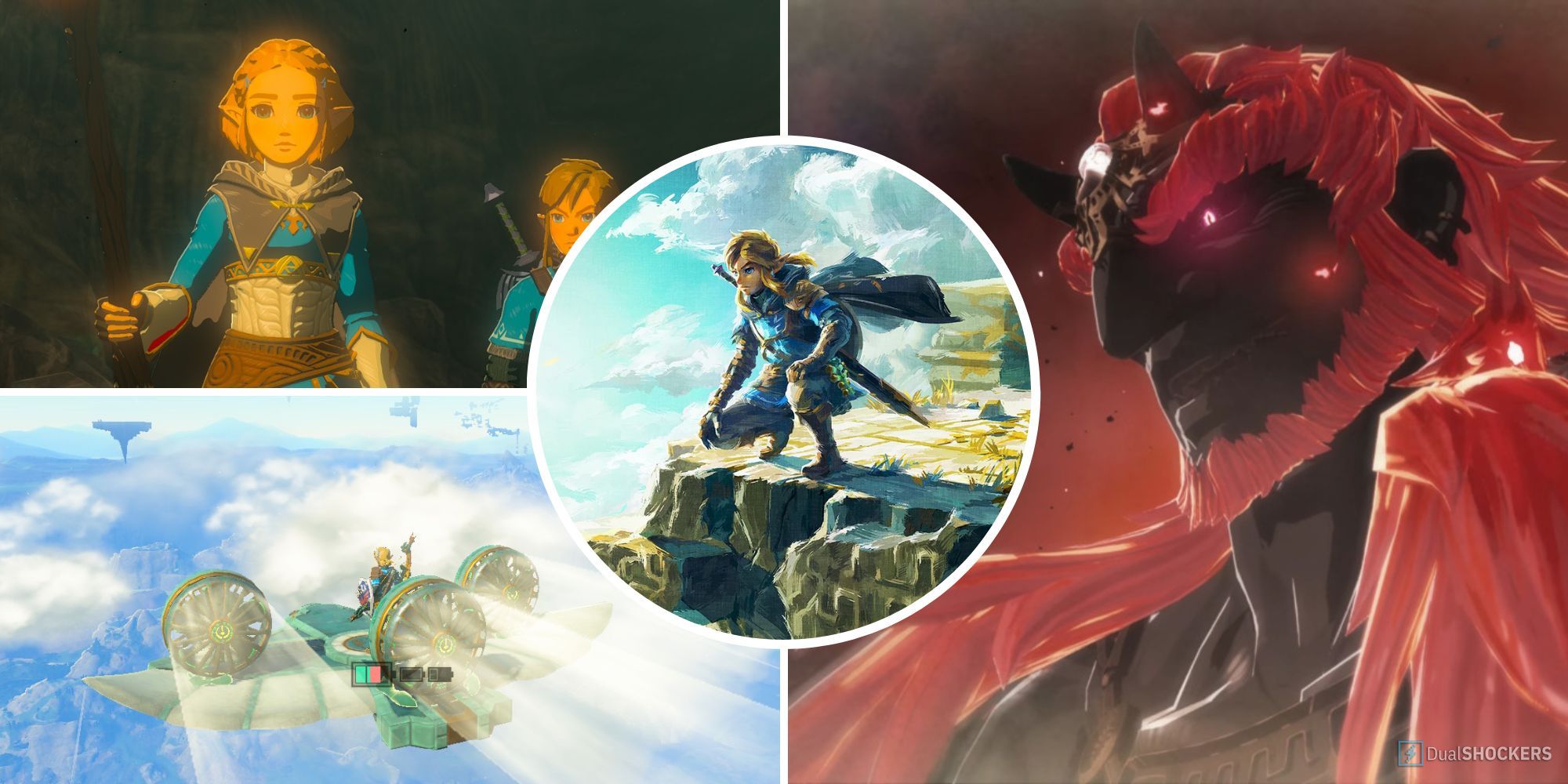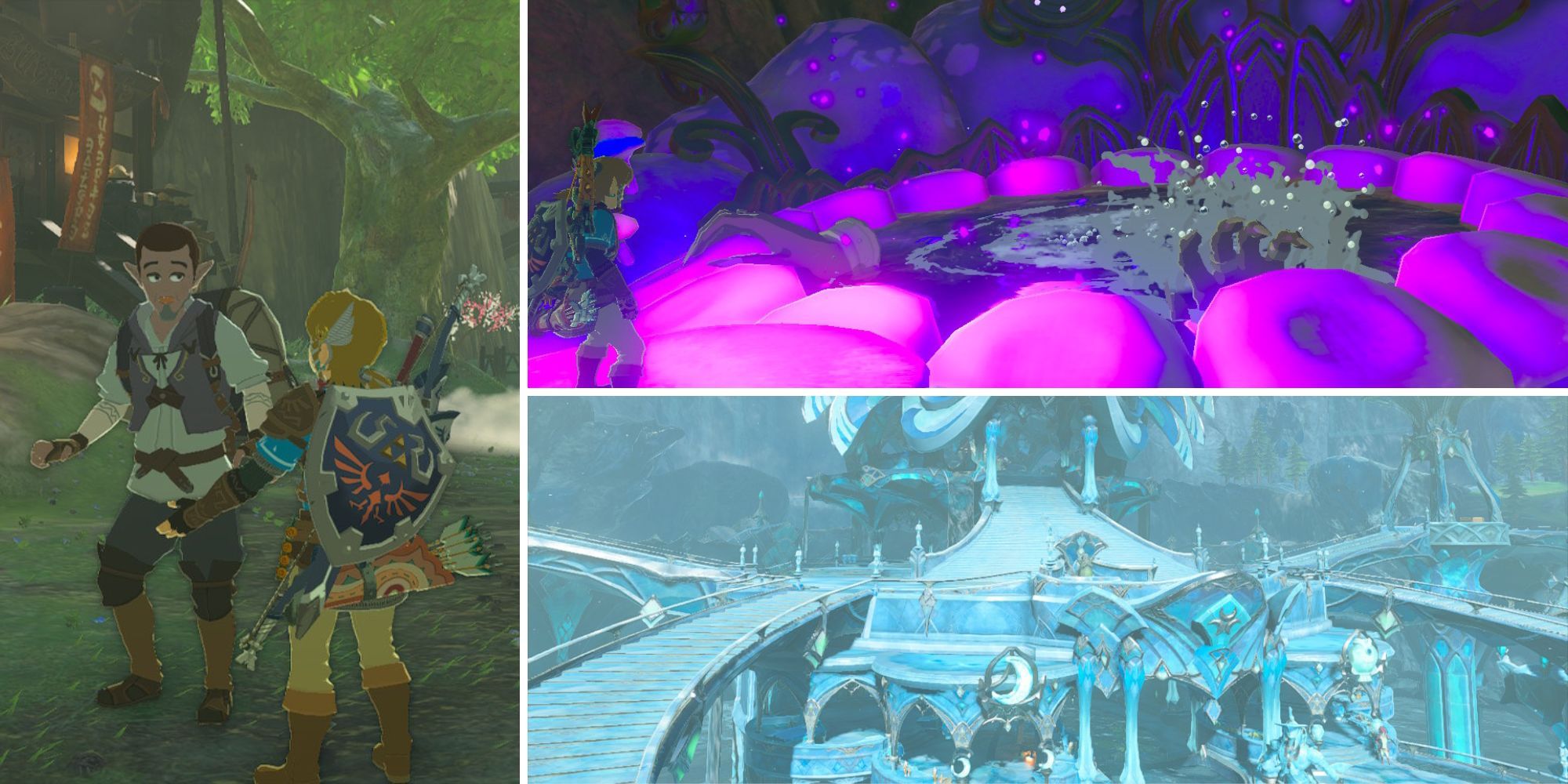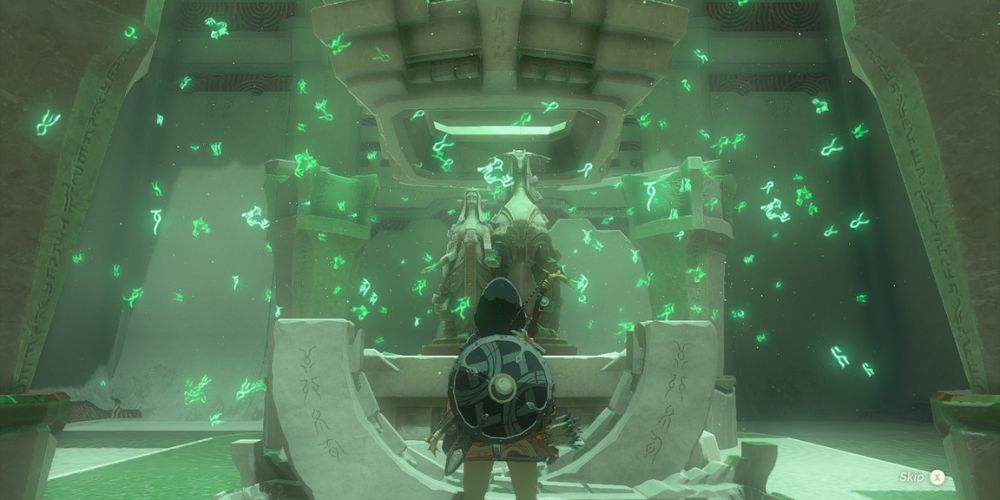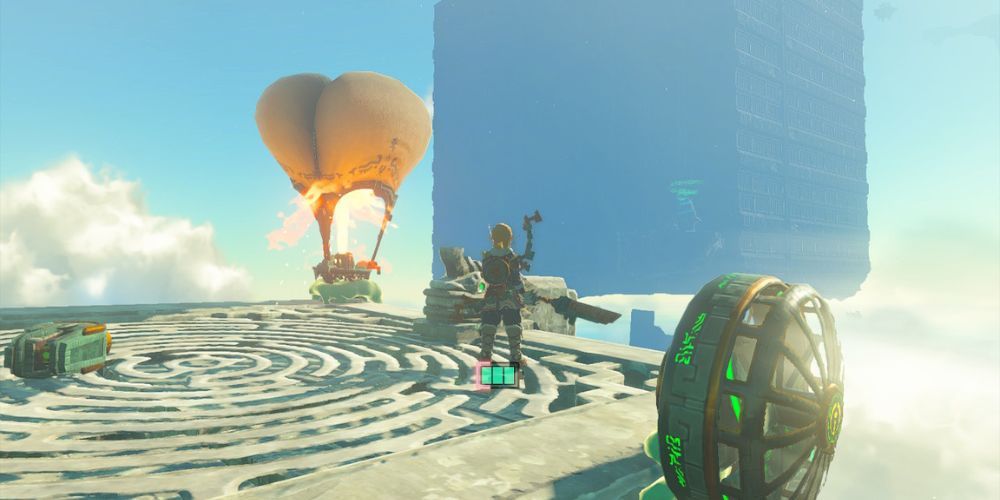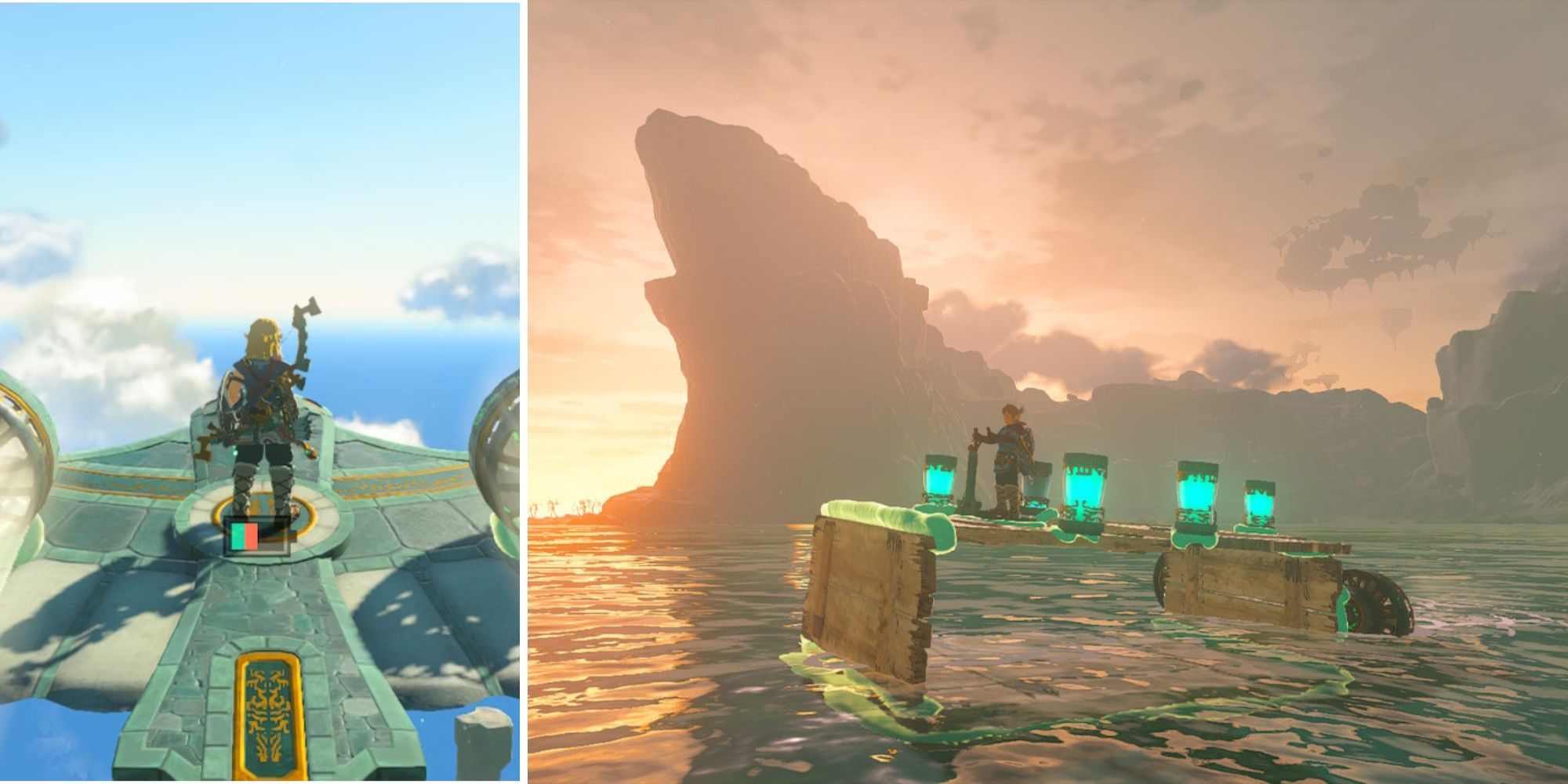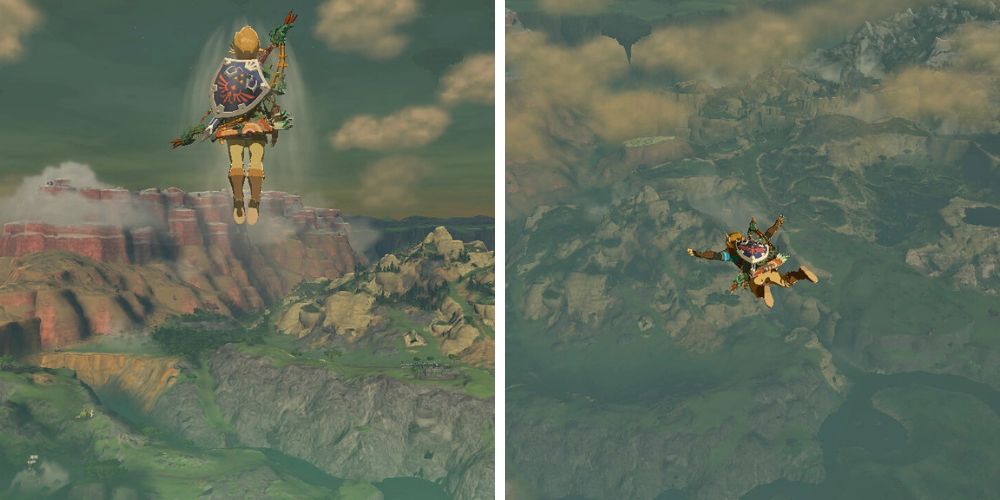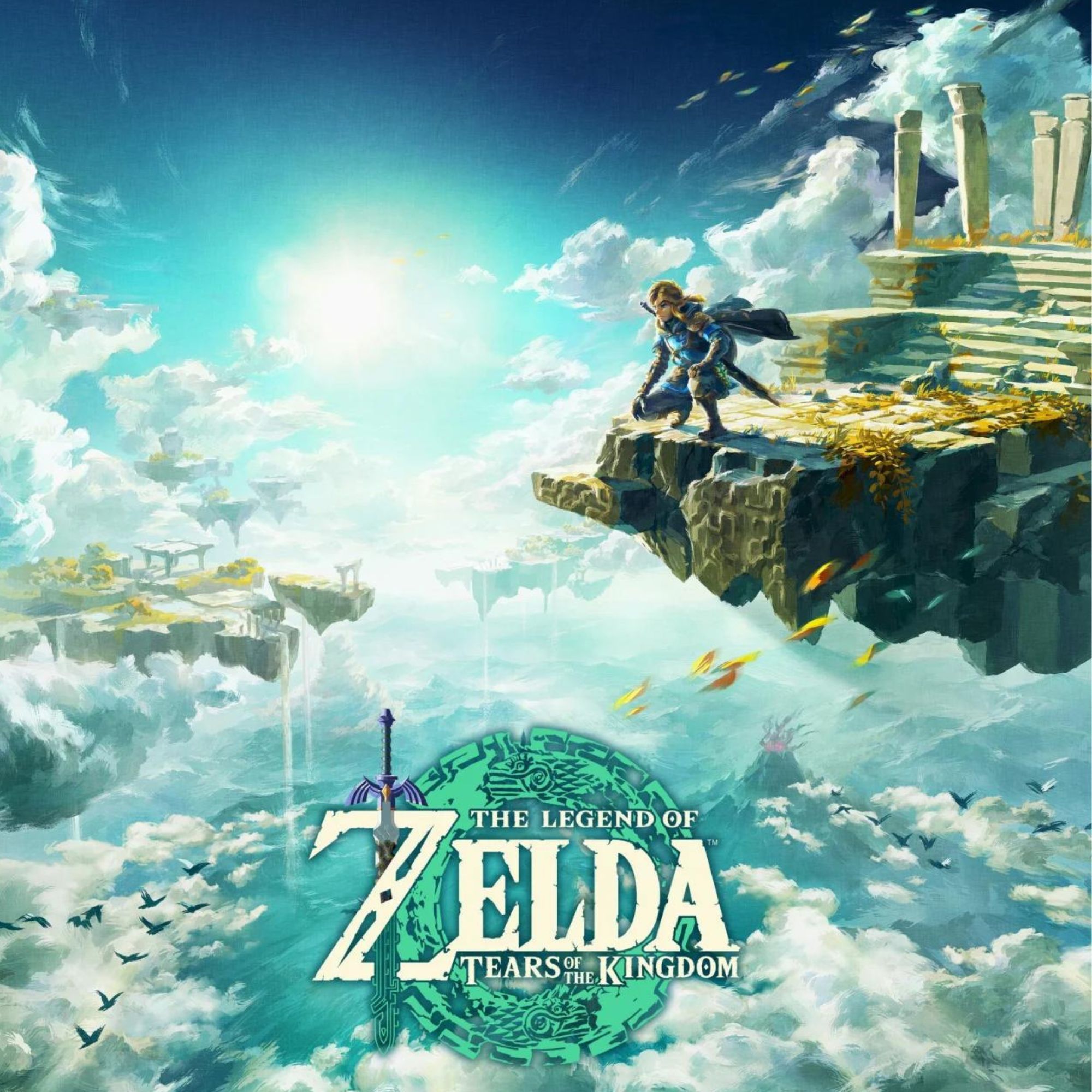
The Legend of Zelda: Tears of the Kingdom
Nintendo Switch
The Legend of Zelda: Tears of the Kingdom is a remarkable sequel, expanding on the mechanics, characters, and setting introduced in 2017's Breath of the Wild. DualShockers was provided a copy of the game for review purposes.
- Released
- May 12, 2023
- Franchise
- The Legend of Zelda
- Platform(s)
- Switch
- Developer(s)
- Nintendo
- Publisher(s)
- Nintendo
- Genre(s)
- Action-Adventure
- Gorgeous open world
- Varied and expansive puzzles
- Fantastic level design
- Rewards curiosity at every turn
- None
Breath of the Wild hit the scene in 2017, and it was personally transformative. Before BotW, I’d bounced off every open-world game I’d played. I never really got them. I always craved a more focused, linear narrative. Breath of the Wild turned my whole appreciation for the format on its head. The beauty and freedom of simply existing in a world – seeing something interesting in the distance and deciding to check it out for no other reason than unbridled curiosity – was a revelation.
Fast-forward six years, and Tears of the Kingdom has finally been released. When revisiting the map and world of one of the greatest games of all time, there comes a certain level of trepidation – will it feel too similar? Will it do enough to live up to the high bar that Breath of the Wild set? Not only does it recapture that lightning in a bottle; it makes the previous bottle look small and quaint by comparison.
Tears of the Kingdom’s story revolves around a primary mystery: where is Princess Zelda? The game utilizes a similar structure to Breath of the Wild: Link’s adventure takes him all over Hyrule as he tracks down clues to Zelda’s whereabouts, helps communities solve their various problems, and investigates the great Upheaval – Ganondorf’s revival – which caused the earth to tear open, spewing the Sky Islands up high above, and opening vast chasms to the dark world below. While adventuring, Link comes across memory fragments that offer insights into what Princess Zelda is up to, creating the dual narrative of both Link and Zelda on their separate but inexorably linked adventures.
Compelling as that tale may be, the story was never going to be the big draw for me with this game – the mechanics and moment-to-moment gameplay are what I’ve been eagerly awaiting. Even so, the narrative of this game is so engaging. As I slowly found the answers to the game’s mysteries, I’m happy to say that the story and lore are an unexpected high point in a game packed full of constant, incredible moments.
Tonally, TotK does offer quite a different experience compared to its predecessor. In Breath of the Wild, the world was almost serene, presenting a more contemplative experience marked by sudden intensity when a Guardian spotted you. Yes, you could discover communities and villages, offering wonderful reprieves from the wilds, but most of the game saw Link on a solitary adventure, visiting the ruins of the pre-Calamity world. Tears of the Kingdom’s world feels much more alive, with so many people responding to the Upheaval. All the characters you know and love are taking active roles in investigating the event, searching for the missing Princess, and generally trying to help people however they can. Tears of the Kingdom still offers moments of quiet contemplation as you traverse the mountains, skies, and rivers of the world, but the difference really comes down to BotW’s exploration in the calm after an apocalypse, versus TotK’s adventure taking place during another great calamity.
The story and lore are an unexpected high point in a game packed full of constant, incredible moments.
While it’s the same Hyrule explored in Breath of the Wild, every major location has been affected by the Upheaval in its own unique ways. Whether it's Sky Ruins raining Down over Kakariko Village or a mysterious sludge polluting the once pristine waters of Zora’s Domain, each of these locations feel familiar, though they’ve gone through a transformative event. Visiting Rito Village or Gerudo Town feels like a fundamentally different experience than in Breath of the Wild. The characters at these locations have continued their lives since BotW, and their own personal stories have been greatly impacted in the time since Calamity Ganon was defeated and the Upheaval took place.
Travelling out in the world offers many of the familiar pursuits that Breath of the Wild veterans know and love, plus a variety of new activities. You’ve got familiar Bokoblin camps to raid, new caves to explore, wells to delve into across the land, Zonai shrines to complete, side quests to discover, and Korok puzzles to solve. These aren’t usually waypoints littering the world map, but simply activities you stumble across as you travel. Just as Breath of the Wild exemplified the sense of wonder by spotting something in the distance and going to investigate, Tears of the Kingdom accomplishes the same level of wonder in a Hyrule changed by the Upheaval.
This sense of wonder is magnified significantly while venturing into the Depths – the vast underground section that is literally the size of Hyrule surface. It offers an enormous number of new locations to explore, deadly new enemies to fight, and an actually ominous, foreboding feel to suit the evil Gloom that thrives down there. While the Sky Islands were the pretty face the game showed off leading up to release, they’re a fraction of the vastness of adventure the Depths offer.
That isn’t meant to denigrate the islands floating high overhead, however. The Sky Islands are a great mix-up from the general gameplay flow. I’d come across a piece of debris that had recently fallen from the clouds, climb on top of it, activate Recall on the ruin, and ride it back up into the clouds. Sometimes, this would bring me close to a new Sky Island to explore. Other times, this would simply give me a fantastic view of the lands below, offering an even greater chance to spy something new or interesting I’d want to check out and glide toward.
The Sky Islands themselves are fantastic puzzles. Similar to a kind of outdoor shrine of sorts, they offer unique challenges – whether that’s navigating with rockets and fans between hostile Zonai constructs or searching for a green crystal in the bowels of a neighboring Sky Island, each visit feels like a fantastic and fresh experience, made all the more magical by being set high over the lands far below.
Once, after completing a somewhat involved Sky Island, I realized I was pretty close to one of the sky cube labyrinths – a great mystery that had been dominating the northwestern skyline while I traversed the Hebra Mountains. I grabbed one of the floating Zonai platforms, attached two hot air balloons onto two flamethrowers, attached a few extra batteries, and three fans. I didn’t have a steering column yet; I was just aiming into the void and hoping for the best. After activating it, I scooted across the sky, making micro-adjustments along the way (repositioning a fan here and there to course-correct). The cube labyrinth got closer and closer. My batteries were dying, but I was also making great progress; between the hot air balloons and the fans, I was actually climbing to a pretty remarkable height while also getting within paragliding range. After my batteries died, I used a few of my own portable batteries I’d collected earlier to keep the devices charged. Just as I was nearly there, my flying contraption suddenly dissolved – I assume I’d taken it much farther than it was ever meant to go – but I was close enough that I could casually glide down onto the sky cube’s landing, just outside a shrine.
I felt like I’d broken the game, but that’s the incredible beauty of Tears of the Kingdom; they unleashed me with a lot of bizarre tools, and they all just… work together. For any given puzzle, there are a dozen solutions only limited by your imagination. Even if you’re feeling a bit creatively bankrupt, you can make some simple yet effective puzzle solutions. For as many times as I feel incredibly clever for how I solve a puzzle, there are just as many times when I’m a complete buffoon and brute force a puzzle by building an absurdly long bridge.
For all the wonder and creativity that Breath of the Wild instilled with its robust Stasis and Magnesis powers, Tears of the Kingdom’s Zonai abilities make BotW look like a fun first draft. The ability to attach literally any object to another object with Ultrahand is absolutely ridiculous and always leaves a dumbfounded smile on my face. Using Ascend to leap into the ceiling, swim through solid rock, and pop out the top side is an incredible power. On multiple occasions, I got into a situation where I’d exhausted all of my options; I was simply stuck. I was in too deep, unable to climb out, and I had no rocket to attach to my shield. And then, right before I give up and just teleported to the nearest Shrine, I remember Ascend. It’s frustrating how often I forget it exists, since it’s such an incredibly versatile tool, but it’s also an ability that I have never in all my years of gaming even thought ‘that’d be a cool thing to do.’ It’s bizarre, but it’s also genius.
The star for me, though, might just be Recall. Recall allows you to reverse time on a specific object. Any object. I wrote earlier about using it on falling debris to travel back up into the sky. But it can also act as a cheat code for so many situations. Having trouble getting across a large gap? Well, I’ll just use Ultrahand to move a platform to the far side, then move it back over to me. After that, I’ll climb aboard, activate Recall, and ride the platform back to the other side as it retraced the journey. Come across a tough enemy? Why not spin a tree trunk around with Ultrahand, lure the enemy into range, then use Recall to have the log pummel the enemy into submission?
Tears of the Kingdom’s Zonai abilities make Breath of the Wild look like a fun first draft.
All of these powers combine in mind-blowing and creative ways that, at every turn, make me question out loud: “How is this all actually working?” Like… a hugely popular pastime was watching Breath of the Wild clips of talented players basically breaking the game with the tools provided. Tears of the Kingdom feels like the devs saw all of that and decided to just give players the most broken tools possible to see what happened. And it just works. I’m astonished that, with all the chaos happening on screen and all the bizarre shenanigans and monstrous constructions, the game has never crashed. I’ve not run into a single bug. This is an incredibly polished game that gives the player the most ‘try to break it’ toolset I’ve ever seen.
I’d also be remiss if I didn’t touch on (and praise) the dungeons in the game as well. They’re still built in the non-linear way that the Divine Beasts were designed in Breath of the Wild, rather than the key/map/compass design of previous Zelda titles, but they are also expanded from what we saw in BotW. Each Temple offered a fantastic thematic personality, complete with some great puzzle solving and pretty incredible lead-ups – from the location’s main story quest through to the excellent path leading to each Temple. You do get a kind of Temple-specific ability introduced to add a new puzzle-solving tool, somewhat similar to the Champion’s Abilities you received in Breath of the Wild. Nothing as expansive as the Zonai abilities, but welcome additions to Link’s toolset, and they all further enhance the uniqueness each temple provides.
The Switch is getting up there in years. Even Breath of the Wild, which came out back at the launch of the Switch, still dropped frames and chugged in specific areas of the world (looking at you, Korok Forest) or during particularly intense gameplay moments when there’s just a lot happening on screen. Tears of the Kingdom isn’t leaps and bounds better than its predecessor, but its performance is pretty similar – and considering the absurd number of gadgets and gizmos in this game, it’s frankly remarkable that it runs as well as it does. I still run into the occasional slowdown when exploring certain areas (looking at you AGAIN, Korok Forest) – and especially now with the potential for creating an actual fighter jet out of spare parts and flying around, blasting enemies out of the sky with mounted lasers – but the vast majority of my gameplay experience was unmarred with noticeable slowdowns. I’m constantly blown away by what Tears of the Kingdom manages to pull it off with only the occasional stutters – not to mention a complete lack of crashing – as I ride, drive, fly, leap, and flail across Hyrule.
Tears of the Kingdom is a remarkable sequel. Not only does it improve on every single aspect of Breath of the Wild, but it expands the characters, locations, and setting in new and exciting ways. It provides the most ridiculous toolset imaginable that at every turn has left me astonished at what I’m able to achieve. It took everything good about Breath of the Wild, reexamined it, and improved upon it to the point that Breath of the Wild looks like a rough draft of a game – and that was already one of my favorite games of all time. Tears of the Kingdom doesn’t make Breath of the Wild obsolete by any means – BotW still offers a unique experience that is in no way tarnished by what TotK has achieved – but Tears of the Kingdom raised the bar for every aspect of the game, bringing the Zelda franchise to new impossible heights. At every point while playing – from 60 minutes to 60 hours and beyond – I have been impressed with everything this title achieved. I know I’m going to be playing it for a long time to come.

